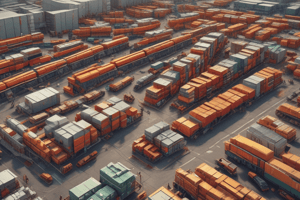Podcast
Questions and Answers
Factory labor charges that cannot be easily traced to a job are treated as
Factory labor charges that cannot be easily traced to a job are treated as
manufacturing overhead
Typical cost drivers include:
Typical cost drivers include:
computer time, machine hours, flight-hours
All manufacturing costs are assigned to units of product and all nonmanufacturing costs are treated as period cost under ___________ costing.
All manufacturing costs are assigned to units of product and all nonmanufacturing costs are treated as period cost under ___________ costing.
absorption
To calculate a predetermined overhead rate, divide estimated manufacturing overhead by
To calculate a predetermined overhead rate, divide estimated manufacturing overhead by
Categories of manufacturing costs include
Categories of manufacturing costs include
Companies that make many different products each period use __________ __________ costing.
Companies that make many different products each period use __________ __________ costing.
Manufacturing overhead costs consist of:
Manufacturing overhead costs consist of:
Compared to plantwide overhead rate system, a multiple predetermined overhead rate system is:
Compared to plantwide overhead rate system, a multiple predetermined overhead rate system is:
A measure such as direct labor hours, or machine hours that is used to assign overhead costs to products and services is called an
A measure such as direct labor hours, or machine hours that is used to assign overhead costs to products and services is called an
The total cost of a job is calculated by adding the total of direct labor cost, direct material costs and
The total cost of a job is calculated by adding the total of direct labor cost, direct material costs and
Widely used allocation bases in manufacturing are
Widely used allocation bases in manufacturing are
The formula for applying overhead to a specific job is
The formula for applying overhead to a specific job is
A job cost sheet contains
A job cost sheet contains
A cost driver is:
A cost driver is:
Labor costs that are easily traced to a job are called ______ labor costs.
Labor costs that are easily traced to a job are called ______ labor costs.
________________ hours would not be a good allocation base for manufacturing overhead.
________________ hours would not be a good allocation base for manufacturing overhead.
Predetermined overhead rate per direct labor hour is calculated by dividing
Predetermined overhead rate per direct labor hour is calculated by dividing
The manufacturing overhead account contains:
The manufacturing overhead account contains:
The document that records the materials, labor, and manufacturing overhead costs charged to a job is:
The document that records the materials, labor, and manufacturing overhead costs charged to a job is:
The total cost of a job includes:
The total cost of a job includes:
A multiple predetermined overhead rate system is more accurate than a plantwide overhead rate system because:
A multiple predetermined overhead rate system is more accurate than a plantwide overhead rate system because:
The unit product cost is the same as the:
The unit product cost is the same as the:
Materials requisition forms are used for:
Materials requisition forms are used for:
A normal costing system applies overhead by job by multiplying a ___________ ____________ rate by the _________ amount of the allocation base incurred by the job.
A normal costing system applies overhead by job by multiplying a ___________ ____________ rate by the _________ amount of the allocation base incurred by the job.
An hour-by-hour summary of an employee's activities throughout the day is found on the _____ ________.
An hour-by-hour summary of an employee's activities throughout the day is found on the _____ ________.
A factor that causes overhead costs is called a:
A factor that causes overhead costs is called a:
Which of the following is an essential quality of an overhead allocation base?
Which of the following is an essential quality of an overhead allocation base?
Based on the information, the predetermined overhead rate per direct labor dollar for department B is:
Based on the information, the predetermined overhead rate per direct labor dollar for department B is:
A single predetermined overhead rate is called a ________ overhead rate.
A single predetermined overhead rate is called a ________ overhead rate.
The predetermined overhead rate is multiplied by the actual allocation base incurred by a job to find:
The predetermined overhead rate is multiplied by the actual allocation base incurred by a job to find:
Manufacturing overhead costs are:
Manufacturing overhead costs are:
An allocation base is a(n)
An allocation base is a(n)
A bill of materials contains:
A bill of materials contains:
The process used to assign overhead costs to products is called overhead __________.
The process used to assign overhead costs to products is called overhead __________.
The formula y = a + b(x), X represents the ________________.
The formula y = a + b(x), X represents the ________________.
Overhead application is the process of:
Overhead application is the process of:
In the formula Y= a + bX, b represents the estimated:
In the formula Y= a + bX, b represents the estimated:
In the formula Y=a+bX, this represents the estimated:
In the formula Y=a+bX, this represents the estimated:
The formula for applying overhead to a specific job is:
The formula for applying overhead to a specific job is:
The process used to assign overhead costs to products is called overhead ________.
The process used to assign overhead costs to products is called overhead ________.
Smith, Inc. uses a job-order costing system with the predetermined overhead rate of $12 per machine-hour. The job cost sheet for Job #42A listed $12,000 in direct labor cost, $18,000 in direct materials cost, 1,200 direct labor hours and 1,100 machine hours. What is the total cost of Job #42A?
Smith, Inc. uses a job-order costing system with the predetermined overhead rate of $12 per machine-hour. The job cost sheet for Job #42A listed $12,000 in direct labor cost, $18,000 in direct materials cost, 1,200 direct labor hours and 1,100 machine hours. What is the total cost of Job #42A?
Companies assign costs to products and services to:
Companies assign costs to products and services to:
Cost-plus pricing occurs when:
Cost-plus pricing occurs when:
The adjustment for underapplied overhead:
The adjustment for underapplied overhead:
To calculate the unit product cost using the job cost sheet:
To calculate the unit product cost using the job cost sheet:
Total manufacturing overhead costs tend to:
Total manufacturing overhead costs tend to:
Why do companies use a predetermined overhead rate rather than an actual overhead rate?
Why do companies use a predetermined overhead rate rather than an actual overhead rate?
Flashcards are hidden until you start studying
Study Notes
Manufacturing Overhead and Costs
- Factory labor that cannot be directly traced to a job is categorized as manufacturing overhead.
- Manufacturing overhead includes indirect costs, fixed costs, and a variety of items.
- Key categories of manufacturing costs include manufacturing overhead, direct materials, and direct labor.
- The total cost of a job combines direct labor costs, direct materials, and applied manufacturing overhead.
Cost Drivers and Allocation Bases
- Typical cost drivers include computer time, machine hours, and flight-hours.
- Allocation bases, like direct labor hours and machine hours, are crucial for assigning overhead costs to products.
- A cost driver is defined as a factor that causes overhead costs to occur.
- The allocation base must be common to all company's products and services to be effective.
Job Order Costing and Overhead Application
- Companies producing diverse products often use job order costing.
- A job cost sheet records materials, labor, and manufacturing overhead charges for a specific job.
- A predetermined overhead rate is calculated by dividing estimated manufacturing overhead by an estimated allocation base.
- The formula for applying overhead to a specific job is: predetermined overhead rate x amount of allocation base incurred by job.
Overhead Systems and Accuracy
- A multiple predetermined overhead rate system provides greater accuracy compared to a plantwide overhead rate, reflecting departmental differences.
- Total manufacturing overhead costs typically remain relatively constant.
- Companies rely on predetermined overhead rates because actual rates are unavailable until the end of the accounting period.
Costing Techniques and Pricing
- The unit product cost is equivalent to the average product cost per unit or total job cost divided by total units.
- Cost-plus pricing involves adding a markup percentage to the cost of a job to determine selling price.
- Underapplied overhead adjustments increase Cost of Goods Sold (COGS) and decrease net operating income.
Measurement and Documentation
- Materials requisition forms help control material flow into production and assist in making accounting journal entries.
- Time tickets provide an hourly overview of employee activities to help track labor costs accurately.
- The bill of materials outlines the quantity and type of direct materials needed for product completion.
Summary of Formulas
- Direct labor costs + Direct material costs + (Predetermined overhead rate x Actual machine hours) = Total job cost.
- Unit product cost = Total job cost / Number of units produced.
- The formula for applying overhead: predetermined overhead rate x amount of allocation base incurred by job.
This structured overview encompasses the crucial concepts found in managerial accounting related to job costing, overhead allocation, and cost management.
Studying That Suits You
Use AI to generate personalized quizzes and flashcards to suit your learning preferences.




